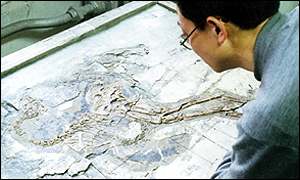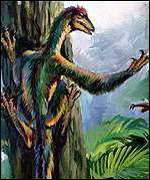The feathered dinosaurs of Liaoning

The hills of Liaoning have yielded
hundreds of fossils
Astonishing fossils are being pulled
out of the ground in the remote hills of Liaoning Province, China. The
specimens, particularly those of tiny, feathered dinosaurs, are fuelling the
debate about the origin of birds.
Slowly but smoothly, the night train
glided north-east from Beijing into Liaoning Province. By six in the morning we
had reached the bustling city of Jinzhou from where we continued on a
white-knuckle taxi ride, praying that the next corner would not conceal a lorry
attempting to overtake a donkey cart on the wrong side of the road.
|
It is strange to think that the
terrible T. Rex may have hatched cute fluffy chicks
|
|
Martin Redfern |
My guide was Dr Zhou Zhonghe, from the Institute
of Vertebrate Palaeontology and Palaeoanthropology in Beijing. He is a rarity
among bright young Chinese scientists in that he has returned home after
completing his PhD in the USA at the University of Kansas.
What lured him back were not the overnight
train rides or the bumpy roads but the fantastic fossils that are being
uncovered in the hills of Liaoning.
We drove between parched, brown fields and
passed low mud-brick farms. An icy wind blew from Siberia to the north. The
farmers buttoned up their coats against the chill as they gathered every last
scrap of vegetation in the hope that they could keep their donkeys alive
through another winter. Two years of drought have also meant these are
impoverished people.
But as we came to the little village of
Sihetun, there was a subtle difference. There were a few modern villa-style
homes and some of the young men were riding new Japanese motorbikes. Clearly,
there was an additional source of income here.
Fluff to feather
We found it on the hillside just behind the
village. In what looked like a huge quarry, researchers were excavating some of
the most exciting fossils yet discovered: dinosaurs with feathers.
The fossils have been dated to 124 million
years ago, in the lower Cretaceous period. At that time, there was a shallow
lake here and anything that fell into it soon got buried under mud and volcanic
ash. As a result, many skeletons have been preserved intact. The fine shales
even display traces of the creatures' feathers.
|
|
More than 1,000 specimens have been discovered here
and in the surrounding region. They provide strong evidence of an evolutionary
link between dinosaurs and birds. But the story is not simple, not least
because there are so many different creatures of various sizes, ranging from
pigeon to pony covered with plumage ranging from fluff to feather.
Most of them seem to belong to the group of
dinosaurs called dromeosaurs. These are the little fast-moving creatures such
as Velociraptor, made famous by the film Jurassic Park. They in turn
belong to the larger group known as theropods, which includes the mighty
carnivore Tyrannosaurus Rex.
The most dinosaur-like examples were clearly
too heavy to fly and their feathers were too small and primitive. One species,
called Sinosauropterix, had only a faint fuzz of fibres around its body;
these may have been downy feathers, though others suggest they could have been
hair or flaps of skin.
Missing links
Dr Zhou Zhonghe points out that the smaller a
dinosaur was, the harder it would have been for the creature to control its
body temperature. Perhaps, the first feathers developed for thermal insulation
and later for display.
Some have suggested that larger relatives were
warm blooded and that their babies would have benefited from insulating down.
It is strange to think that the terrible T. Rex may have hatched cute
fluffy chicks!
|
The smallest adult dinosaur, Microraptor |
There are plenty of fossils from Liaoning of
creatures that clearly could fly. One species, named Confuciusornis, has
been found in large numbers and is very bird-like with big, quilled, flight feathers
and a beak.
The palaeontologists are searching hard to find
missing links between birds and dinosaurs. In 1999, they thought they had one.
It was purchased in the US for $80,000 from a dealer.
A small fraction of that money had probably
helped to buy a Chinese farmer a motorbike before the fossil was smuggled out
of the country. The export of vertebrate fossils from China is illegal but some
of the local officials who are meant to enforce the law seem to have acquired
fine specimens themselves.
The supposed "missing link" was named
Archaeoraptor and was featured as the cover story in National Geographic
magazine. But it was soon found to be a fake, a composite of a bird-like
creature with the tail of a more primitive theropod dinosaur.
Common ancestor
When a layered rock is split open to reveal a
fossil, you are left with two halves - part and counterpart. The breakthrough
in this story came when Xu Xing of the Institute of Vertebrate Palaeontology
was able to purchase, for a mere $5,000, the counterpart of the tail stuck on
to Archaeoraptor.
With it came the animal that really belonged to
the tail, and it was the smallest theropod dinosaur ever found. It was named Microraptor
and the discovery was reported in the journal Nature in December 2000.
About the size of the pigeon, Microraptor
also had feathers. It had relatively powerful, long legs and might have been
able to fly with a good run-up on the ground. But it is more likely that it was
a tree climber.
Microraptor had
the sort of curved, pointed claws on its feathered forelimbs or wings that are
seen in things like woodpeckers and squirrels, which climb tree trunks. One toe
on each hind leg is pointed back as in birds, for perching. Maybe it could
launch itself from the branches and at least glide if not fly.
There are still those who dispute hotly that
theropod dinosaurs gave rise to birds and they have one undeniable piece of
evidence in their favour. The oldest known bird, Archaeopteryx, from
Germany, is 26 million years older than the feathered theropods from Liaoning,
so the latter could not have been their ancestors.
Zhou Zhonghe's PhD supervisor in Kansas,
Professor Larry Martin, disagrees with his student and thinks that birds and
dinosaurs had a common ancestor far further back in the geological record.
But for most fossil experts, the evidence is
clear. The feathered dinosaurs of Liaoning have many features in common with
birds and not only feathers. They have a primitive wishbone, the bone in the
chest that braces the body against the flight muscles in birds. And they have a
characteristic half-moon shaped bone in their wrists, which enables birds to
flap their wings wide. The debate is bound to continue but the number and
quality of fossils still being discovered in Liaoning means that there will be
plenty more evidence.

Archaeoraptor turned out to be a fake
BBC

